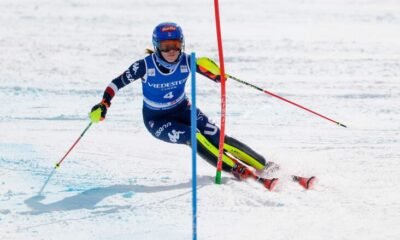Blog
Mikaela Shiffrin achieves her best World Cup giant slalom finish since the devastating November incident at Killington
“Finding Her Rhythm Again: Mikaela Shiffrin’s Emotional Return to Form in Sölden”
SÖLDEN, Austria — Mikaela Shiffrin has always been synonymous with dominance. Her name has become a byword for precision, grace, and relentless pursuit of perfection on the slopes. Yet, on Saturday, as she crossed the finish line in fourth place at the 2025/26 FIS Alpine Ski World Cup opener, it wasn’t victory that defined her — it was resilience.
For the woman who has 101 World Cup victories to her name, finishing outside the podium might once have felt like a disappointment. But after a year marked by pain, doubt, and recovery following a frightening crash in Killington last November, Shiffrin’s fourth-place finish in Sölden felt almost like a win.
The Road Back From Fear
It’s been 11 long months since that crash in Vermont — one that could have changed everything. As Shiffrin skied into a gate during her giant slalom run, the world watched her tumble violently, her skis scattering and her body sliding to a stop in silence. For someone known for precision and control, the fall was jarring, almost unthinkable.
The aftermath was more than just physical. Shiffrin suffered a knee injury that required careful rehabilitation, but the emotional scars ran deeper. Giant slalom — once her comfort zone — had become something she feared.
“I needed to make peace with GS again,” she admitted earlier this month in an interview. “It’s strange to say, but it felt like I had to learn to trust the snow again — to trust myself.”
Saturday’s race in Sölden showed that process in motion. It wasn’t just about speed; it was about rediscovering confidence turn by turn, gate by gate.
Starting From Bib 20 — And Fighting Through
When the start list came out, many fans noticed Shiffrin’s bib number: 20. For most racers, that means difficult conditions — rougher snow, deeper ruts, less grip. But for Shiffrin, it was an opportunity to test herself.
Her first run was careful, calculated. Sixth place at the halfway mark wasn’t ideal, but it was solid — a reminder that she could still compete among the best. Then came the second run.
Shiffrin attacked with her trademark precision, her edges slicing cleanly through the icy course. She looked like herself again — smooth, fast, and composed. When she crossed the line, her combined time was good enough for fourth, just fractions of a second away from the podium.
For the first time in nearly two years, she had posted her best giant slalom finish since early 2024 — a small but deeply meaningful triumph.
“I’m really happy with this,” Shiffrin told reporters afterward, smiling softly. “Of course, everyone wants to win. But today was about feeling connected again — with my skiing, with GS, with racing. And I did.”
A New Kind of Victory
What made the result so satisfying for Shiffrin wasn’t the number next to her name — it was the way she earned it. This was a comeback built not on dominance but on patience and courage.
Her longtime coach, Mike Day, summed it up best after the race: “For Mikaela, this wasn’t about chasing perfection. It was about rebuilding trust — trusting her body, her turns, and the process. Fourth place today might mean more to her than a win did two years ago.”
Indeed, the road back hasn’t been easy. In addition to her crash, Shiffrin faced months of therapy and cautious training sessions where she had to fight the instinct to push too hard too soon. There were moments of frustration, times when she questioned if she could return to her old form.
But those close to her — including her fiancé, Norwegian skier Aleksander Aamodt Kilde — say she never truly lost her drive. “She’s one of the strongest people I know,” Kilde said recently. “When she commits to something, she sees it through. Always.”
Lessons From the Fall
Shiffrin’s journey over the past year has been as much mental as physical. Her crash forced her to confront a part of herself that fans rarely see — the vulnerable side of a champion.
She spoke earlier this season about how fear changed her perspective. “I used to think bravery was just attacking every turn,” she said. “Now I see that bravery can also mean stepping back, taking your time, and doing things right, even when it’s slower.”
That shift in mindset has given her a new kind of strength — one that might make her even more dangerous in the long run.
“She’s skiing with emotion again,” said NBC analyst Steve Porino. “And when Mikaela connects her emotions to her technical precision, that’s when she’s at her absolute best.”
The Bigger Picture — What It Means for the Season Ahead
Shiffrin’s fourth-place finish in Sölden might just be the spark she needed heading into a packed Olympic season. The 2025/26 campaign will be full of challenges — from the tight race schedule to the looming pressure of Milan-Cortina, where she’ll chase another Olympic gold.
But Sölden reminded everyone, including Shiffrin herself, that she’s back in control of her narrative. The physical form is returning, and the mental calm that defines her greatest performances is clearly settling in.
Her next few races — particularly the slalom in Levi and the technical events in Killington — will be crucial markers. Yet, for now, Shiffrin seems content simply to be back doing what she loves.
“I’m grateful,” she said quietly after the race. “Grateful to be here, grateful to be healthy, and grateful to feel like myself again.”
The Emotional Weight of the Comeback
For long-time fans, this performance was about more than numbers — it was about seeing a champion rediscover joy. The image of Shiffrin smiling in the finish area, surrounded by teammates and coaches, said it all.
There was no visible frustration, no glance at the scoreboard with disappointment — just a look of calm satisfaction. She knew what this meant.
“She’s learning to enjoy the process again,” said U.S. Ski Team director Patrick Riml. “That’s when Mikaela’s at her most dangerous. When she starts skiing for the love of it, not the pressure, that’s when the wins come naturally.”
The Road Ahead
As the World Cup season gains momentum, Shiffrin’s focus will now shift to maintaining rhythm and consistency. She knows that form builds over time and that patience is her greatest ally.
For her fans, the message is clear: Mikaela Shiffrin is not just back — she’s evolving. The crash that once seemed like a cruel twist in her story has instead become a turning point.
And as the snow settles in Sölden, one truth stands out — champions aren’t defined by how often they win, but by how they rise when they fall.
In that sense, Mikaela Shiffrin didn’t just find her rhythm again. She found herself.
-

 Blog4 months ago
Blog4 months agoPat Kelsey sends a strong three-word fiery message to the Louisville basketball’s team after their Cardinals 14th win…
-

 Blog7 months ago
Blog7 months agoNetflix releases “The Underdog,” a much-anticipated documentary about Drew Brees. slated for publication on the 25th
-

 Blog4 months ago
Blog4 months agoMikaela Shiffrin responds to cross-country skier Jessie Diggins’ letter following her failure to secure a solitary podium finish at the FIS Nordic Worlds
-

 Blog2 months ago
Blog2 months agoBehind the Turns: Netflix’s Upcoming Documentary on Mikaela Shiffrin’s Fights, Fears, and Love
-

 Blog4 months ago
Blog4 months agoWomen’s Slalom Run 1 at the FIS Alpine Skiing World Cup: Are
-

 Blog4 months ago
Blog4 months agoLegacy Tour Led Zeppelin has officially confirmed their 2026 reunion tour, which will be their first extensive live performances since 2007. The “Led Zeppelin Legacy Tour 2026” will begin on June 10, 2026, at Los Angeles’ SoFi Stadium.
-

 Blog6 months ago
Blog6 months agoFederica Brignone: “I’m fine, but my return to skiing is far off.”
-

 Blog6 months ago
Blog6 months agoAlice Cooper: From Fragile Boy to Shock Rock Icon—Netflix Unmasks the Nightmare
